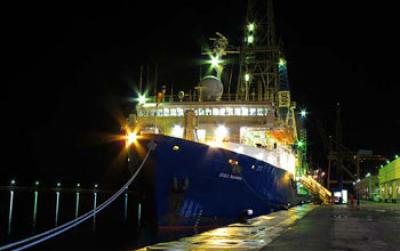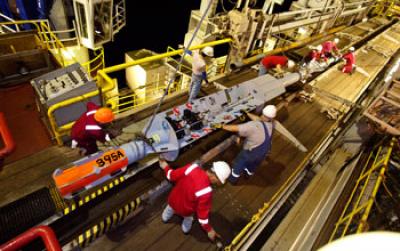
Expedition Looks for Life Beneath Earth's Crust

How do you catch one of the most mysterious, yet possibly most abundant organisms on Earth, which is also invisible to the naked eye and happens to live in one of the most inaccessible places on the planet? Build a nice house for it — and wait.
Such is the predicament and solution for scientists trying to study the microbes that live in the rocky, waterlogged crust beneath the world's oceans.
"It's a huge habitat just in terms of volume, and there is a fair amount of energy available to support life," said Wolfgang Bach, a petrologist at the University of Bremen in Germany and the co-chief scientist on a research expedition that recently installed two observatories (called CORKs, or Circulation Obviation Retrofit Kits) deep below the bottom of the North Atlantic Ocean. The project is a part of the International Ocean Drilling Program, which is sponsored in part by the National Science Foundation.
The observatories, two sealed-up holes drilled deep into the ocean floor, are designed to essentially provide some irresistible real estate for sub-seafloor microorganisms, and over the course of the next several years, scientists will return to see what has moved in.
In the holes, the researchers installed chunks of different types of rocks and minerals, such as basalt, olivine, and various forms of iron, which naturally occur deep in the ocean crust, within different chambers built into the observatories, offering any microbes that happen to arrive inside the CORKs a series of apartments to choose from.
"We leave them in there for five years and when we retrieve those — that's a big moment." Bach told OurAmazingPlanet.
Mysterious microbes
Get the world’s most fascinating discoveries delivered straight to your inbox.
Much about the microbes that dwell deep below the oceans is mysterious. In fact, nobody has ever caught them alive. Yet there are indications that their sheer numbers are enormous, representing up to a third of the biomass on the planet.
"There may be countless cells — astronomical numbers," Bach said. "But they are barely metabolizing," he said. "They don't do much, which makes it extra hard to find them and to figure out what they do."
The microbe observatories are drilled into a specially selected spot on the ocean floor, about 60 miles (100 kilometers) away from the Mid-Atlantic Ridge, a long volcanic riftbisecting the Atlantic Ocean, where two tectonic plates are being slowly shoved apart and fresh oceanic crust is created.
Where the CORKs are installed, "the crust is still young, and it's still permeable, so seawater can circulate, but it doesn't get very hot," Bach said — an environment that is hugely abundant beneath the Earth's oceans, and therefore provides a good snapshot of possible microbial habitat there. [Strangest Places Where Life Is Found on Earth]
Uncertain return
Several suites of CORKs have been installed in ocean floors around the world. Recently, scientists wrapped up a study on observatories along the Juan de Fuca ridge, in the northeastern Pacific Ocean — a subsea environment far hotter than that of the CORKs in the North Atlantic.
In April, the team will return to the North Atlantic observatories armed with Jason, a remotely operated vehicle (ROV) that can dive down and retrieve data for the scientists waiting on the ship above.
The ROV will link up to the top of the CORKs and download electronic data — temperature and oxygen levels — that will indicate if the boreholes have returned to a natural state ("if the dust has settled," Bach said), and retrieve some fluid from each of the observatories' chambers.
Ideally, once the CORKs return to their natural state, containing only seawater that seeps in from the surrounding rocks, instead of from the ocean above, the native microbes will move in and stake a claim.
The ROV will also fetch a stack of containers housed in the cap of the CORKS that are essentially a miniature version of the would-be microbe condos inside — a stack of around 10 minerals and rocks, supplied with a constant flow of seawater drawn from inside the observatories.
Bach said it's hard to know what to expect when the team returns, but that the key thing they'll be looking for is a sign that the observatories have returned to a natural state.
"We know very little about these systems," he said. "Of course I hope it has turned around already when we get there, but it's very difficult to predict how long it's going to take. I'm kind of a pessimist because then I won't be disappointed."
- Extremophiles: World's Weirdest Life
- Gallery: Amazing Creatures from the Census of Marine Life
- Amazing Photos: The Little Things in Life
This story was provided by OurAmazingPlanet, a sister site to LiveScience. Reach Andrea Mustain at amustain@techmedianetwork.com. Follow her on Twitter @AndreaMustain. Follow OurAmazingPlanet for the latest in Earth science and exploration news on Twitter @OAPlanet and on Facebook.



